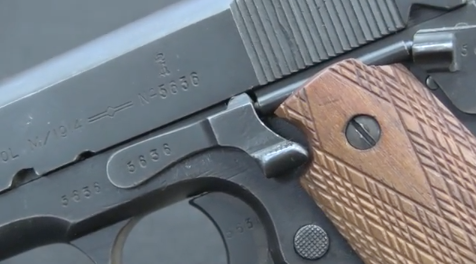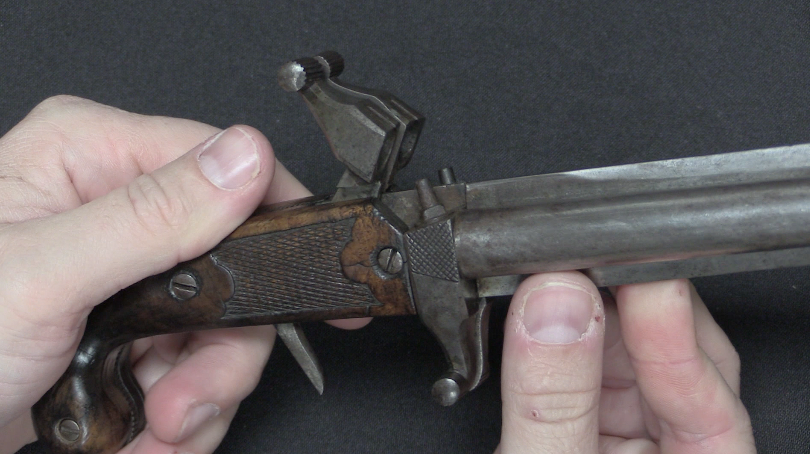Harald Sunngård was Norwegian inventor in the early years of the 20th century who noticed a common perceived weakness of automatic pistols: reloads under stress were often bungled by shooters, leaving them vulnerable to return fire without being able to shoot back. Doing the classic inventor thing, Sunngård figured out a solution to the problem – a two-part solution, in fact. The first part of his solution was to use a big magazine and a small cartridge, to maximize magazine capacity. The second part of his solution was to store a spare magazine right in the magazine well of the pistol for immediate use.
The grip of the pistol is long enough front-to-back to store two identical magazines. The front magazine sits higher than the rear one, and the boltface on the slide feeds rounds from the front magazine into the chamber. Once the front magazine is empty, the shooter ejects it, and need only slide the rear magazine into the front position (and rack the slide) to continue shooting. There is a misconception that the pistol will fire automatically from both magazines in succession, but this is not true.
In addition to having the handy spare available, Sunngard designed the magazines to hold no fewer than 25 cartridges each (in the more common 6.5mm chambering). This gave the pistol a total of 50 rounds stored on-board, which was a major point in Sunngard’s marketing.
The 6.5mm cartridge designed for the pistol had a 23mm overall length, and used a 19mm case. The projectile was a scant 28.5 grains (1.85 gram), and Sunngard claimed a muzzle velocity of just under 2000 ft/s (600 m/s) – which is almost certainly an exaggeration. There was also an 8mm version of the pistol made in much smaller numbers, which fired an equally light projectile (29gr / 1.88g), and may have gotten closer to the claimed velocity (magazines for the 8mm version held 18 rounds each).
The main magazine catch is basically a heel release on the front edge of the magazine well, and it is pushed back in the typical manner to allow the primary magazine to be removed. Then the rear magazine is pulled slightly forward and down as if to remove it from the gun. The rear magazine is then slid forward into the front position and pushed back up to lock into place on the magazine catch. A pair of small guides at the top of the magazine well prevent the magazine from being pushed backwards into the now-empty space for the spare magazine, and these guides are the reason the spare mag must be pulled down and then pushed back up. When initially loading the pistol, the spare magazine is inserted first, and locked back into its compartment. Then the primary magazine is inserted just like in any other pistol.
Sunngard apparently tried hard to market the pistol to a variety of military forces, but found no takers. He was able to get the gun entered into the 1914 Norwegian military trials, where it was bested by the Colt 1911 (we don’t have a testing report from the trials, which would be very interesting to read). If I had to guess based on the general attitudes of the day, I would suspect that Ordnance officers found the reloading process awkward, the cartridge underpowered, and the need for a very high capacity pistol unconvincing.
Mechanically, the Sunngard is pretty simple. It uses a plain blowback action, as no locking system is necessary for its small cartridge. The barrel is fixed to the receiver, and a recoil spring is located around the barrel and inside the barrel shroud/slide.
If you enjoy Forgotten Weapons, check out its sister channel, InRangeTV! http://www.youtube.com/InRangeTVShow




0/10 on the pronounciation of Sunngård. Å is not an A by any stretch of my, your, or anyone else’s imagination. At least listen to the Google Translate lady say it!!!!
Ole, I’ve shouted your name often at bullfights. Ole!
Right-o: Sunngård in English would be more like “Soon-gourd.”
In Swedish there are, of course, three extra vowels: å ä och ö.
The existence of “hard vowel” vs. “soft vowel” sounds and how these effect the pronunciation of the letter “g” is quite vexing for us non-natives who’d like to learn at least a bit.
How is the rear magazine loaded into the pistol?
Are you running out of ideas In?
^Ian
All this (mostly impractical) inventiveness and tinkering was possible and even necessary, because there was not a standard for semi-auto pistol at the time. People like designer of this creation were pioneers in true sense. Thanks for showing it.
Exactly. It’s an incredibly creative pistol design.
“Stop it, stop!! You’ve already emptied four magazines into him!!”
“(…)6.5mm cartridge(…)”
if I understand this: http://www.earmi.it/armi/atlas/214a.htm correctly, powder charge was 0,27 g. However it looks suspiciously big for such small cartridge:
http://municion.org/6Mm/6_5Sunngard.htm
Is that real charge? If yes what kind of powder was used?
When you looking for this cartridge, I incidentally found this:
http://municion.org/6_35x18_5/6_35x18_5.htm
If I understand correctly, it is linked to FN, it was created in 1953-1954 by (? for? on behalf of?) Dieudonné Saive [designer of SAFN-49] as something like .25 Auto with additional power and thus was dubbed Grande Puissance and only 1000 [examples] were made.
What was muzzle velocity and bullet mass? Was automatic pistol created for it, or it never go to this stage? What event spawned development of this cartridge?
Aside from the awkward grip angle, it seems that the anemic calibers offered would require you to shoot the target 5 or more times to effectively stop them. So is it any better than a single stack 9mm? I believe this is the question the military asked and why the gun never won approval.
This gun is remotely related to OTs-23 DROTIK in general concept. OTs-23 was produced in limited numbers, due to same reason – limited effectiveness of cartridge (5,45×18) used. Ability to fire in fully-automatic mode was found to not balance this limitation.
There were many high capacity guns early on. The mechanics worked, but at the cost of using very weak cartridges, which made the guns pretty much useless.
That is cooler than Bugs Bunny in the Arctic. The designer was obviously very clever (maybe too clever) did he go on to design more guns I Imagine he would come up with something equally wacky.
Early auto pistols. Gotta love them. You never know what will work till you try.
Buuuuut, a giant .25 ACP (practically) is a bit of a non-starter. The adoption of the 1914 just might have been a wise decision.
Another Scandinavian found a better way. George Kjellgren’s Kel-Tec PMR-30 delivers 30 rounds of .22 Magnum from a similar sized pistol with only one magazine, plus hot .22 Magnum loads are more powerful than .25 ACP.
Interestingly, out of the FN Five-Seven pistol’s 4.8 inch barrel, the 5.7 x 28mm round with a 40-grain bullet has a MV of ~1,500 F/S for ~200 FPE. A 40-grain .22WMR leaves the muzzle of the PMR-30 at ~1,400 F/S for ~174 FPE. I doubt the target would notice the difference, and the PMR-30 has a 30-round magazine to the Five-Seven’s 20-round. Hitting the target with controlled pairs or triples, you won’t run out of ammunition as fast with the PMR as with the 5-7.
Most sources on the 5.7 x 28mm (notably Wikipedia) only quote the figures for the lighter 28 to 31 grain bullets out of the longer barrel of the FN P-90, about 2,800 F/S and ~ 340 FPE. The P-90’s longer tube brings those lighter bullets up to the energy levels of a 9 x 19mm or .45 ACP. In the pistol barrel, though, you’re basically shooting the centerfire equivalent of a .22 WMR out of a similar pistol. It just costs more for the pistol and the ammunition.
Hypervelocity small-bore rounds are only more efficient if they really achieve hyper velocities. Otherwise, you’d be as well off with a hot .22 rimfire tactically, and much better off financially speaking, as the PMR-30 and .22WMR are both much cheaper than a Five-Seven and 5.7 x 28mm.
cheers
eon
“(1.85 gram), and Sunngard claimed a muzzle velocity of just under 2000 ft/s (600 m/s) – which is almost certainly an exaggeration.”
This lead to question what was real muzzle velocity?
Also, it would be interesting to know why such light bullet was used – in fact much smaller diameter 5mm Clément cartridge has very similar bullet mass, which according to
https://unblinkingeye.com/Guns/Clement/clement.html
is 28 grains heavy.
This reminded me about .45 Schouboe cartridge, which also has very light bullet for its diameter: http://municion.org/Schouboe/45Schouboe.htm at 4,2 (around 65 grains)
Jens Schouboe was really ahead of his time in ballistic theory. He understood that “big bores” had been necessary for increased power in the black-powder era, simply because there’s a limit to how much velocity you can get from a pistol or even a rifle barrel with BP due to its inherent burning characteristics.
With an upper limit of about 800 to 900 F/S for a pistol-length barrel, the only practical way to increase killing power was to use a heavier bullet, which meant a larger bore diameter, otherwise you’d have a bullet that was too long for stability in flight.
The old 200-grain .38 S&W British military load and the American 200-grain .38 Special “Super Police” load were a case in point. They had excellent wounding power precisely because their marginal stability caused them to begin turning end over end inside the target and not stopping, unlike a “normal” solid-nosed revolver-type bullet that generally rotates 180 degrees once on entry, and continues traveling through the body material backwards. However, their accuracy beyond about 50 meters was questionable at best, but in most actual tactical usage this was largely irrelevant.
The .45 ACP round is the “black powder stopping power” design concept carried over to smokeless powder ammunition; 230 grain bullet, MV av. 850 F/S, ME av. 360 FPE. Ballistically speaking, in most respects it was a self-loading reiteration of the old .45 Colt black-powder revolver round.
Schouboe also understood something most armies didn’t want to admit; that most handgun “kills” in combat happened within 50 yards. While long-service veterans might be sharpshooters at 200 yards with a 7.5 in barreled .45 M1873 “cavalry” revolver, cavalry was on its way out due to the machine gun, infantrymen had rifles, and officers on foot wouldn’t be engaging targets much beyond seven to ten yards based on visibility alone.
As such, he went to the first principle of smokeless-powder hitting power; Speed Kills. And developed a simple self-loading pistol firing a round that generated high kinetic energy (about 500 FPE) at ranges out to about 50 meters. Beyond that, energy fell off rapidly, but within its practical range it would be a nasty man-killer.
The U.S. Army didn’t like it at all, as it didn’t fit with their vision of the way a soldier traditionally shoots. I don’t think Schouboe cared much about “tradition”, he was just interested in something that worked in real-world conditions.
When the U.S. Army adopted the 9 x 19mm in 1986, and put the .45 ACP out to pasture, it was more-or-less acknowledging that the whole “stopping power” thing with big bore handguns was mostly a myth. And that they’d probably have been better off taking John M. Browning’s advice and adopting the German round back in 1911.
And of course today, high-velocity, light-weight, frangible bullets (which the Schouboe bullet would definitely qualify as) are considered the ne plus ultra of short-range man-killing power in 9 x 19mm weapons.
Jens Schouboe was a classic example of a genius who was just a bit too early in his field. Because today, the experts pretty much all agree with him, including those who have never even heard of him.
cheers
eon